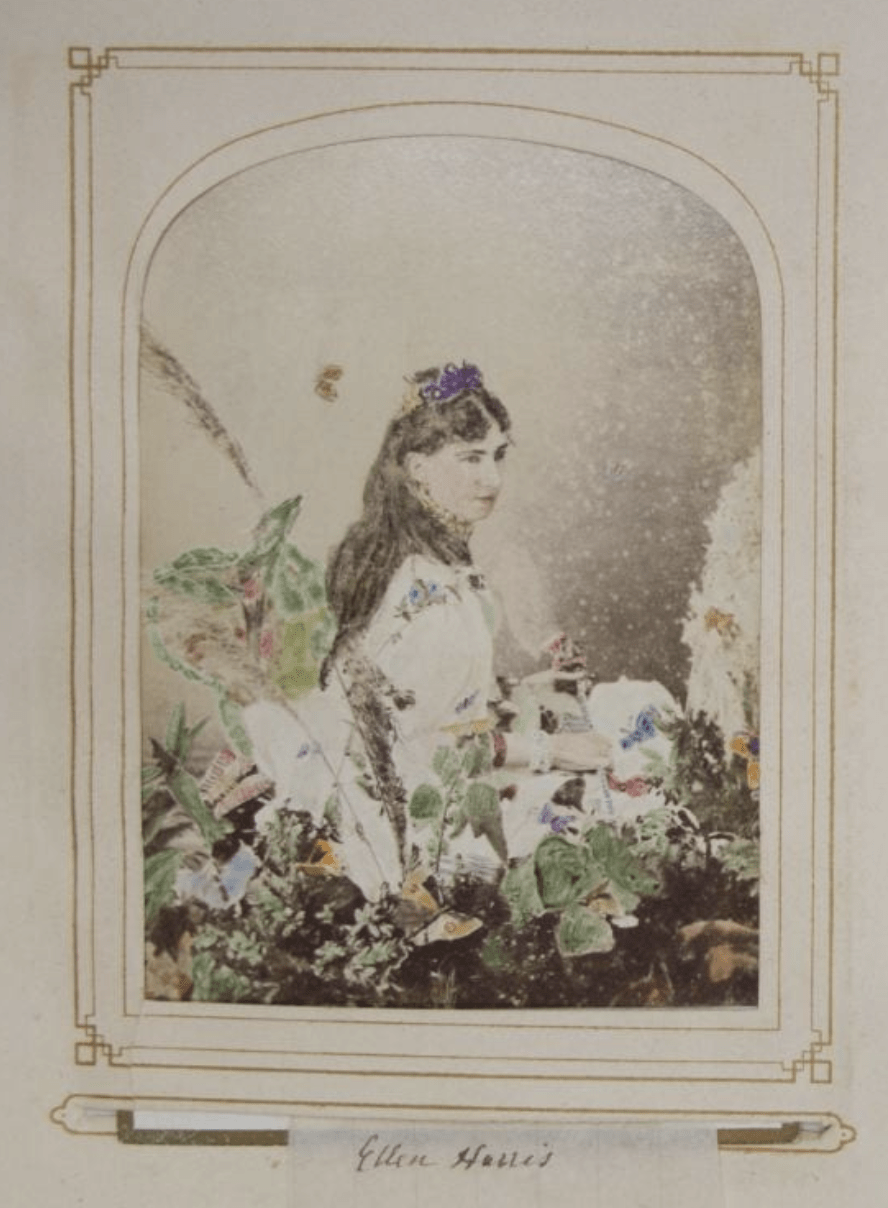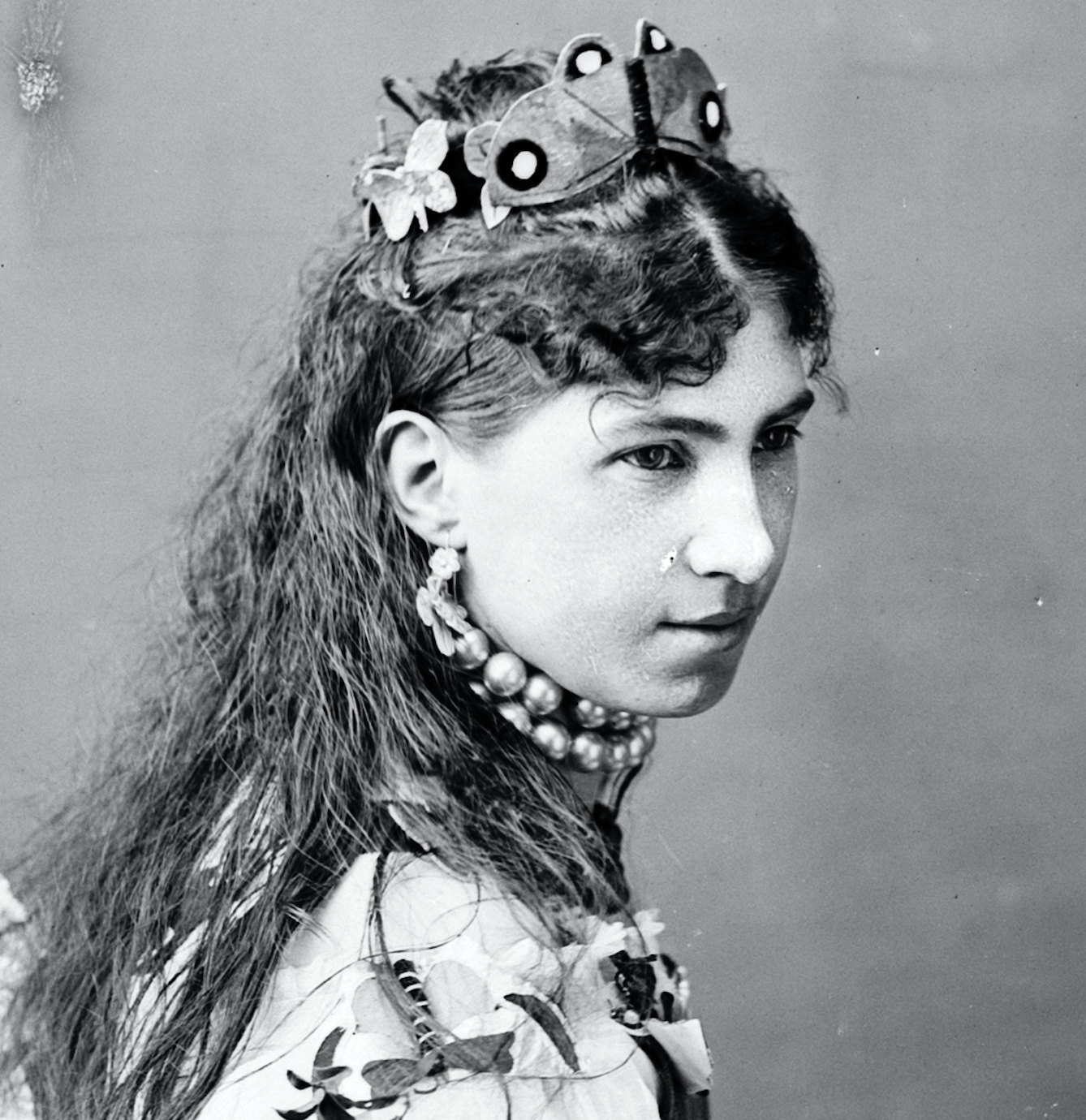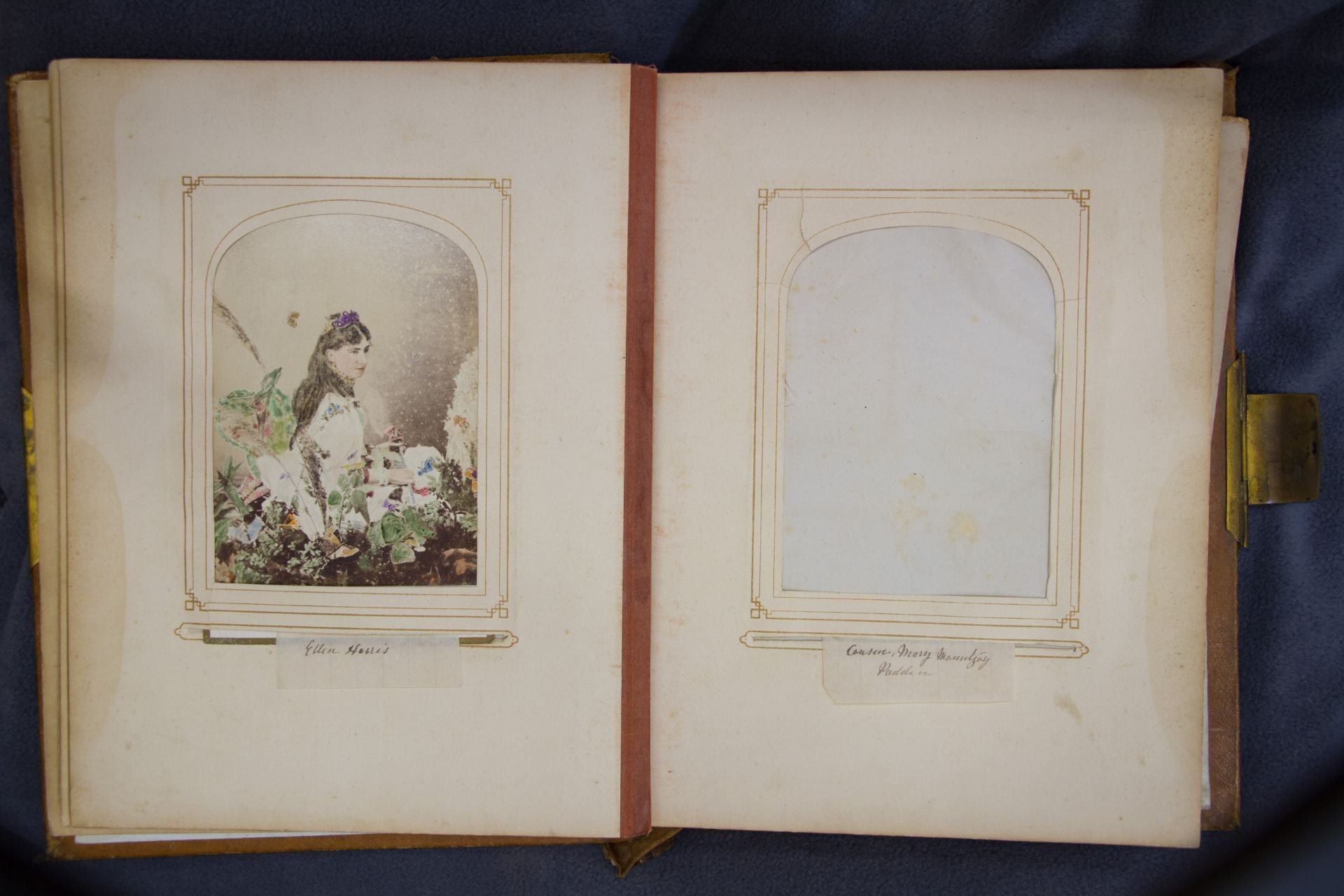Ellen Harris surrounded by plants, flowers and butterflies. It’s one of the most striking photos in the Family Album and the most elaborate photo we have of any of the sisters. While working on the ‘Sisters at a Glance’ posts, we began to refer to it as the ‘fairy tale’ photo when discussing the many different photos of Ellen. So distinctive from the other pictures and such an ethereal outfit, was there an occasion for this? A play? Could we find out?

There are two copies of the photo, a hand-coloured version in the family album and a black and white version in the Nelson Provincial Museum, and both give clues to the time period. The photo in the Family Album has a photography stamp (Bloch/Block) which suggests the 1870s while the Nelson Provincial Museum copy of the photo suggests the early 1880s through the name of the collection (Akersten- who ran the photography studio in question after Bloch). This gave us a period of the 1870s to 1880s to search for an occasion, event or play that would fit the costume Ellen is wearing.
Searching for Ellen in PapersPast in that 1870-1880s period brought up Nelson’s 1875 Fancy Dress Ball, designed to raise funds for the Lunatic Asylum, showing up right in the middle of our search period. Ellen is mentioned by name as attending as ‘Queen of the Butterflies’, suddenly giving us a year for the photo (1875), a name for the costume (the Queen of the Butterflies), and an event to investigate (The Fancy Dress Ball). There are a few mentions of the fancy dress ball before its arrival, the local papers containing articles urging people to purchase tickets in advance, announcing a one week postponement (possibly due to a clash with the arrival of the Bishop of Wellington), advertising fancy dress shoes, or generally building excitement for the event:
Fancy Dress Ball. — In view of the forthcoming Fancy Ball in aid of the recreation fund for the Lunatic Asylum, Mr Maclaren advertises fancy boots of every description. Having had an opportunity of inspecting some of the boots of Mr Maclaren’s make, we can recommend all who are in want of such articles to pay him a visit. (Nelson Evening Mail 12 Jan 1875: 2)
Fancy Dress Ball —The forthcoming fancy dress ball on Friday next in aid of the Lunatic Asylum Recreation Fund ought to prove a success, judging from the preparations which are in progress. All the stage scenery for the interludes is complete, and the musical rehearsals are going on smoothly and satisfactorily. Without professing to give an exact programme, we may relate that the selections include a scene from a favorite play, two opera choruses, the Witches’ scene from Macbeth, and a musical pantomime ballet ; these will be put on the stage in a thoroughly complete manner between the dances. We recommend those who are doubtful about going, on the score of expensive dress, to call upon Mr Rawson, who will be glad to give any hints to remove that impression. (Nelson Evening Mail 25 Jan 1875: 2)
The ball was held on Friday the 29th of January 1875 and from the reporting it appears it was a great success and was discussed in glowing terms in the papers:
Fancy Dress Ball—A fancy dress ball was held in the Provincial Hall last night. It was got up by some philanthropic gentlemen for the purpose of raising money wherewith to form a recreation fund for the new Lunatic Asylum, and they must be congratulated on the success which has attended their efforts. The ball of last night was the most brilliant affair of the sort that has ever been given in Nelson, many of the dresses, both ladies’ and gentlemen’s, being exceedingly pretty and well chosen. The dances were interspersed with short dramatic scenes, opera choruses, tableaux vivants, &c, which were excellently managed by Mr H. Rawson. Dancing began at half past eight o’clock, and was kept up with much spirit till an early hour this morning. It is hardly necessary to state that the dresses worn by the dancers had a very striking effect. There were nearly one hundred couples present. (Colonist 30 Jan 1875: 3)
Among those attending were the eldest and youngest Harris sisters, Emily and Ellen. In one article listing many of the costumes we can find the entry “Miss Harris, Swiss girl; Miss Ellen Harris, first as Zulieka, and second Queen of the Butterflies.” (Colonist 2 Feb 1875: 3). Another familiar name is the Harris’s neighbour Mr Ambrose Moore who was dressed as Mercutio. Ellen and her costume go on to be mentioned especially in both the Colonist and the Nelson Evening Mail:
Many of the dresses were very beautiful, and it was evident that several of those present had gone to considerable expense in getting themselves up for the occasion. Amongst the best and most effective dresses were those worn by Miss Ellen Harris, Hon. Mr. Edwards, Miss Stanton… (Colonist 16 Feb 1875)

And now, so we get into the crowd, we find it more and more difficult to bestow more than a passing glance at each as he or she passes us by. The goddess Flora was numerously and prettily represented; Spanish ladies, and Continental peasants, met us at every step […] and there was the Queen of the Butterflies, with her gauzy wings and attendant army of the graceful little winged insects which spotted her dress from head to foot, and we felt very much inclined to sing with heart and voice, “I’d be a butterfly,” if one of the conditions of the transmogrification should be that we were to be perpetually paying homage to a sovereign who apparently ruled with so gentle a sway. Ladies of every century that has passed since A.D.1, with patched cheeks and powdered hair, gave an air of dignity to the scene, and this was enhanced by the presence of Cardinal Wolsey, who looked as though he was prepared to pronounce his blessing on all around him. (Nelson Evening Mail 1 Feb 1875:2)

The reports we found on the Nelson Ball detail a number of performances and scenes from plays and operas, in addition to the dancing:
Twenty-two dances were gone through, and at intervals, Mr. H. Rawson, assisted by several other gentlemen, produced several dramatic scenes and opera choruses, with excellent effect. […]
The first scene represented a courtyard in Tunis, with slave merchants in Turkish costume, Circassian captives being sold by dumb-show auction, the chorus being “Merry Tunis,” from the opera “Satanella.” The second delineation was a well-known scene from Goldsmith’s favorite play “She stoops to Conquer,” in which Dr. Boor, as Mr. Hardcastle, acquitted himself very creditably. The third was a very effective scene, representing “Stonehenge” : the spirited invocation chorus from “Norma,” being rendered by nine Druids, surpliced and laurel-wreathed. The fourth, “the Cauldron scene from Macbeth,” was very successful. It represented the interior of a cave, in the centre of which stood the cauldron, over which an owl kept watch. The three witches were excellently personified, and the bats and other night birds were capitally arranged, colored fires adding to the effect. Locke’s music was capitally rendered. The scene was deservedly encored, and repeated. The fifth, described as the ballet termed “the Quaker’s Daughter,” was well sustained. Although there was no spoken dialogue, the intelligent acting and descriptive music conveyed the plot clearly to the audience. (Colonist 16 Feb 1875:5)
Going further afield, several newspapers around New Zealand reported, albeit more briefly, on Nelson’s ball. The Evening Star observed: “A fancy dress ball has actually been given in ‘Sleepy Hollow,’ and on the 29th ult., the anniversary of their Province, the Nelsonites enjoyed themselves amazingly at this novel form of amusement.” (9 Feb 1875: 2)
The letters or diary entries that might have contained first-hand accounts of the excitement or planning amongst the sisters are lost to time but, dancing away in 1875, Emily and Ellen Harris’s presence at the ball survives in the mention of newspapers and Ellen’s cabinet photo.
Lead Writer: Brianna Vincent
Research Support: Michele Leggott
